|
           
|

|
|
 EAT!
Pro! EAT!
Pro!
-
Optimal
muscle preservation
-
Highest likelihood of protein synthesis
-
Enhanced
Performance
-
Tastes Like
A Milkshake
-
Science Based
-
Mixes With Fruit
and Flavors for a Variety of Treats
-
A Valuable Part
of Any Nutrition Program Aimed at Improving Body Composition
EAT
stands for Exercise Advantage Technologies and the product
was designed to provide a supportive blend of nutrients when
a regular meal is not accessible or convenient. The newest version
of EAT!, EAT! Pro! has the same blend of high quality proteins,
the same slow release carbs (13g per serving - to be burned
as fuel allowing the 32 grams of protein to be used for tissue
maintenance, repair and growth), and the same complete vitamin
and mineral combination as its predecessor. It also contains
added L-Glutamine for muscle preservation in the form of glutamine
peptides (pure L-glutamine is destroyed by stomach acids . .
. peptides ensure optimal cellular delivery). The newest version
also has added L-Taurine which is the second most abundant amino
acid in muscle, phosphtidylerine, which limits cortisol production
(cortisol is a muscle-eating hormone), and L-tyrosine for enhanced
alertness and performance. It is not only an alternative to
a supportive meal, but for athletes, exercisers, and weight
trainers . . . it's pretty close to the perfect blend of nutrients.
Here
are some questions that people have asked Phil regarding this
exceptional formula, followed, of course, by Phil's answers:
Q:
What nutrients and ingredients are in your product EAT? Specifically,
what proteins? What carbs? What else? I can't find it in my
local health food store. What stores carry it?
The EAT! Metabolism
Enhancer formula includes a mix of whey protein and egg protein.
Based on all of the research I've looked at, this blend appears
to be the most valuable for optimal usage in the human body.
Whey protein isolate alone, which is advertised as some wonderful
ingredient in many overhyped commercial formulas, has a quick
gastric emptying property. It leaves the stomach so quickly
many of the amino acids wind up getting metabolized. That
means although you may consume 20 or 30 grams, you only have
a small percentage of the protein available to build or repair
cells. The rest is literally burned up by liver enzymes. The
addition of egg protein, long revered as the most biologically
complete protein, slows the release of the whey making the
blend a very high quality protein source from a position of
bioavailability for protein synthesis. It uses a very high
grade of maltodextrin extracted from corn with a slow release
property as its carb source. Maltodextrin should act as a
slow release carbohydrate, since the glucose molecules are
linked together in chains just as they would be in a supportive
carbohydrate food source. The chains in the lesser grades
(which are not identified as such on product labels) are dissolved
or broken apart by enzymes in saliva, thus, although "maltodextrin"
might resemble a slow release carb in a container, with the
lesser grades you wind up putting single glucose molecules
(simple sugars) into your stomach. EAT! uses the highest grade
available. 13 grams of slow release carbs are included to
provide fuel for thermic digestion. These carbs are protein
sparing, preventing protein from being used to meet energy
needs (as is often the case when carb intake is too low).
EAT! also has a complete profile of vitamins and minerals
including anti-oxidants to meet the recovery and health needs
of those who undergo vigorous exercise. I've also added Glutamine
Peptides to add a couple of grams of L-glutamine to a standard
serving (L-Glutamine in its free form is destroyed by stomach
acids - Glutamine Peptides allow you to actually deliver L-Glutamine
to muscle as well as to the various systems where it's used
in recovery).
EAT! Pro! is
sweetened with sucralose. There isn't any sugar. There is
a small amount of essential fatty acids from borage seed oil
mixed into the protein blend. There is also fiber from some
fruit rinds and a non-soluble fiber called inulin (not insulin).
The grades of protein and maltodextrin used make it far too
pricey to manufacture for sale commercially. You'll never
see it on the shelves of health food stores.
Q:
Why don't you make single serving packets?
Single
serving packets was an ingenious marketing move by one major
supplement manufacturer which was followed by all the bandwagon
jumpers who saw product sales escalate. They play up the "convenience"
angle. For years I've been carrying my protein and meal replacement
supplements in single serving packets, better known as "Zip-Lock
Bags!" Is there really a need for single serving packets?
Most packets today approximate between 200 and 300 calories
per serving. Next time you have the chance, look closely at
your next door neighbor. Does he or she appear to have the same
body as you? Look at a pro football player on TV. Wouldn't you
think his nutritional needs are different than your neighbors?
This is a perfect example of how clever marketing can sway an
entire population away from common sense. We all have unique
caloric requirements, thus a "single serving packet"
can not possibly meet the needs of everyone. I've done something
unique with EAT! Every container includes a custom designed
scoop. Each scoop approximates 100 calories. There is a chart
on the container that allows you to approximate your caloric
needs. If you want to carry your EAT! servings with you, I'd
encourage you to splurge for some Zip Lock Bags and scoop in
whatever your optimal serving is!
Q:
What time of day is it best to use EAT?
Don't
make the mistake of believing that EAT! will do anything for
you other than offer you an optimal blend of nutrients when
meals are not convenient or accessible. There is no best time
of day. The goal is to get a supportive meal into your body
every 3 - 3 1/2 hours. When it's challenging to get to a supportive
meal, have an EAT! shake instead.
Q:
Will you be coming out with other flavors?
Probably not.
I never intended to be in the supplement business. The popularity
of EAT! has developed based solely on my commitment to quality.
Since the vanilla milk shake and chocolate milk shake flavors
seem to meet the needs of all of my customers and clients,
I don't feel any need to expand the product line. If you'd
like, you can add some frozen strawberries or frozen bananas
to the vanilla flavor to vary the taste, or if you don't want
to consume any sugar, you can find sugar-free syrups in many
supermarkets.
 The
vanilla formula mixes ideally in a blender with fruit. You
can buy frozen fruit in the freezer section of your supermarket.
Frozen peaches and vanilla EAT! is an incredible peaches 'n
cream treat. Try it with strawberries, blueberries, mango,
or pineapple. My favorite? Fresh kiwi, fresh pineapple, and
frozen strawberries. The
vanilla formula mixes ideally in a blender with fruit. You
can buy frozen fruit in the freezer section of your supermarket.
Frozen peaches and vanilla EAT! is an incredible peaches 'n
cream treat. Try it with strawberries, blueberries, mango,
or pineapple. My favorite? Fresh kiwi, fresh pineapple, and
frozen strawberries.
The chocolate
formula tastes exactly like a chocolate milk shake. In fact,
I drove the formulators near crazy trying to get the "malt"
taste to mix with the cocoa. If you want to be adventurous,
mix the chocolate powder in a blender with a frozen banana
and a tablespoon of almond butter.
At my seminars,
we've given out samples of vanilla mixed with sugar-free pina
colada mix, chocolate mixed with peanut butter and graham
crackers, and a variety of tropical flavors blended with crushed
ice.
Q: Do you use EAT!
Of course I personally
use EAT!, not only because of the quality, but I really love
the taste. In the past, I'd find a product, use it for a few
weeks, and grow tired of the taste. I've been using EAT! for
over 10 years and still think it tastes better than anything
else out there. This wasn't an accident. Once I refined the
formula, taste was a challenge. Minerals have a metallic taste.
Other ingredients further alter the taste. The first batch
tasted awful. I had it reformulated again and again and finally
it tasted fantastic. I tested it firstly with my staff, secondly
with my clients, and thirdly in random taste tests among health
club populations. The first release of EAT! was sweetened
with aspartame and acesulfame. As EAT! grew in popularity,
I still continued to refine the taste. The current formula
is a 4th Generation and based, not only on my own opinion,
but also upon the continued responses of customers,
I can say there
is no better tasting formula on the market.
I mix EAT! with
cream of rice and frozen peaches for a delicious supportive
breakfast, I mix it into whole grain pancakes to add vanilla
flavor and protein, and I mix it into yogurt and granola cereal.
I have come to rely on EAT! as it's the perfect complement
to the supportive meals I strive to obtain on a daily basis.
I feel it important to walk the talk, and EAT! helps to make
that possible.
Order 1 container
for $39.99
EAT! Pro!
Nutritional Summaries
|
| Net
Wt. 910 g (2 lb.) |
|
| Serving
Size 52 g |
Servings
Per Container 17.5 |
| Calories |
200
|
| Calories
From Fat |
18
|
| Total
Fat |
2
g |
| Saturated
Fat |
0.5
g |
| Cholesterol |
20 mg
|
| Sodium |
150
mg |
| Potassium |
120
mg |
|
|
| Total
Carbohydrate |
13
g |
| Sugars |
<1
g |
| Protein |
32
g |
| Added
L-Glutamine |
2
g |
| Added
Ingredients: Taurine (as L-Taurine), Tyrosine (as L-Tyrosine),
Phosphatidylserine (from Lecithin) |
| Directions:
1 serving is 2 level scoops. It is recommended that
you mix with 6-8 oz. of cold water. Each scoop is custom
measured to approximate 100 calories. You can customize
the calorie content by adding additional scoops and an additional
2-3 oz. of water for every 100 calories desired. |
| Primary
Ingredients: Whey Protein Concentrate, Dried Egg Whites,
Glutamine Peptides, Maltodextrin (complex carb, glucose
polymer), Soy Lecithin, Calcium Phosphate, Magnesium Citrate,
L-Glutamine (from glutamine peptides), Inulin (fiber), Sucralose,
Zinc Gluconate, Vitamin C, Vitamin E, Choline, Vitamin A
Acetate, Bioflavanoid Complex, Vitamin B6, Vitamin B2, Folic
Acid, Biotin, Flavoring |
| Additional
Info for Evaluation: When comparing EAT! with commercially
sold products, be sure to compare nutrient values to serving
size. Many products pump up their "Grams of Protein"
by referencing a 400 calorie serving (or more)! Consumers
also do not have a resource for evaluating grades of nutrients,
for example, there are a variety of grades of maltodextrin
which acts as a complex carbohydrate in EAT! The less expensive
grades are more readily converted into glucose. EAT! uses
a very high grade of maltodextrin as well as the highest
quality proteins. |
|
|

